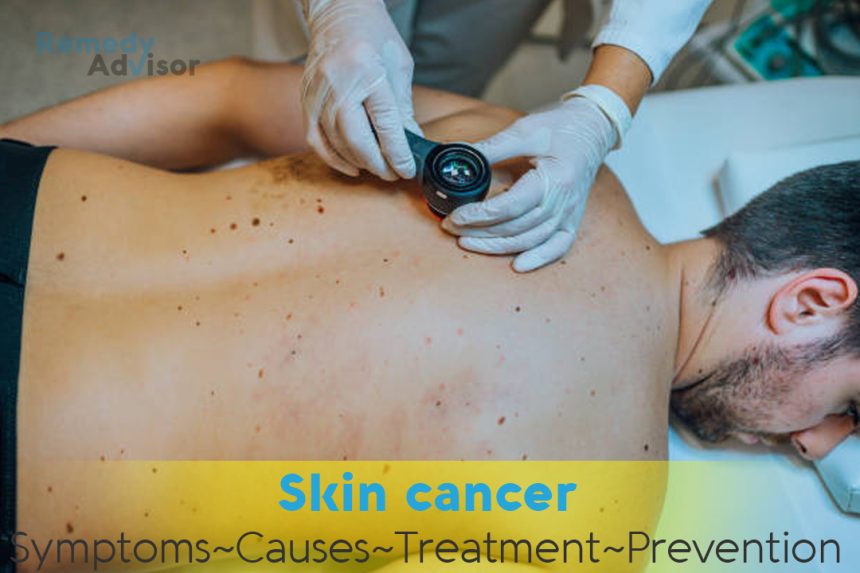What is it
Skin cancer is the most common of all cancers. The skin changes that result in cancer develop cumulatively and irreversibly in an individual over the years, and so may take decades to produce a malignancy. Men get skin cancer more frequently than women, and it usually shows up in older people, but no one is exempt. In fact, Americans are developing skin cancer at ever-younger ages because of the increasing amounts of time spent in the sun. Prolonged sun exposure is the principal cause of skin cancer.
Exposure to the sun’s ultraviolet radiation is known to promote three kinds of skin cancer.
Basal cell carcinoma is the most prevalent type, striking one out of every eight Americans, including people in their 20s and 30s, women as well as men. The most common site for basal cell carcinoma is the face, especially the nose or ears, but it can appear anywhere. It is painless and slow-growing, and rarely spreads to other parts of the body.
Squamous cell carcinoma typically develops on the face, lips, the rim of the ear, and the back of the hands. If not treated, the lesions can grow in size and spread to internal organs.
About 900,000 new cases of these two types of cancer are reported annually in the United States alone. Fortunately, both basal cell and squamous cell skin cancers have a 95 percent cure rate when detected and treated early.
Melanoma, the least common of the three (40,000 cases annually), is also the most dangerous though early treatment can result in a cure. Melanoma develops in the melanocytes cells located in the epidermis and eyes. They produce melanin, the dark pigment that helps protect the skin from ultraviolet radiation. Once rare, the incidence of melanoma has increased five-to six fold worldwide over the past four decades. The lifetime risk is now about 1 in 105 and it may be I in 75 by the year 2000.
Since 1973 the incidence of melanoma has risen about 4 percent a year, even as the use of sunscreen has increased. Whereas melanoma was once a disease of the aging, now half of all those who develop it are between the ages of 15 and 50. Many scientists attribute some of this increase to the gradual destruction of the stratospheric ozone layer, which is allowing more ultra-violet radiation to reach the earth’s surface.
Symptoms
General signs
- Any change in the size, color, shape or texture of a mole or other skin growth.
- An open or inflamed wound that won’t heal.
Signs of basal cell carcinoma
- A sore that doesn’t heal. Have it checked if it hasn’t healed after three weeks and it crusts, bleeds, or oozes.
- A persistent reddish patch. It may be painful or may crust and itch; or it may not bother you at all.
- A smooth bump indented in the middle. The borders will be rolled, and as it grows you may notice blood vessels on the surface.
- A shiny, waxy, scar like spot. It may be yellow or white with irregular borders.
Signs of squamous cell carcinoma
- Small, firm lump or patch, initially painless, that develops on the face or back of the hand. May be raised or flat, with a scaly or crusted surface.
- Slowly grows to take on a wart like appearance; may become painful.
Signs of malignant melanoma
- A mole that begins to enlarge, thicken, or change color. (Some 70 percent of early state lesions are identified because of recent changes in size, color, border contours, or surface texture.)
- A mole that suddenly begins to grow, or one that bleeds or ulcerates.
- A mole that has irregular rather than round borders.
- A mole with irregular pigmentation some portions light colored, others almost block.
What causes it
It is clear that the risk of basal and squamous cell carcinoma rises in proportion to the cumulative amount of time people have spent in the sun. But the sun’s role in the development of melanoma is less clear, and in fact surprisingly little is known about what causes melanoma. People who spend lots of time in the sun (such as farmers) do not have elevated rates of melanoma, though they do have higher rates of squamous and basal cell carcinoma. And melanoma sometimes turns up on parts of the body rarely exposed to the sun (such as buttocks and soles).
Some researchers believe that intermittent sun exposure and severe, blistering sunburns, especially early in life, rather than simply years of sun exposure, cause melanoma. However, studies have been inconsistent about the role of sunburn.
The people at highest risk for melanoma are fair skinned notably people with red or blonde hair, who freckle (especially on the upper back), and/or who have rough red patches on their skin (actinic keratoses) as a result of sunning. If, in addition, you have a family history of melanoma or have had three or more blistering sunburns as a child or teenager, your risk also increases.
What if you do nothing
If untreated, all these forms of skin cancer will ultimately become destructive. Basal cell carcinomas are slow-growing, but it is important that they be found and treated early because they can ultimately invade and destroy nearby tissues. Melanoma that goes untreated may quickly spread to other parts of the body, which is why it is the most dangerous form of skin cancer.
Home remedies
Skin cancer requires evaluation and treatment by a physician.
Prevention
Even if the only risk factor you have is fair skin, you still need to be cautious and to protect yourself. One of the major steps you can take to prevent all forms of skin cancer is to reduce your direct exposure to sunlight, use adequate sunscreens, and wear protective clothing.







